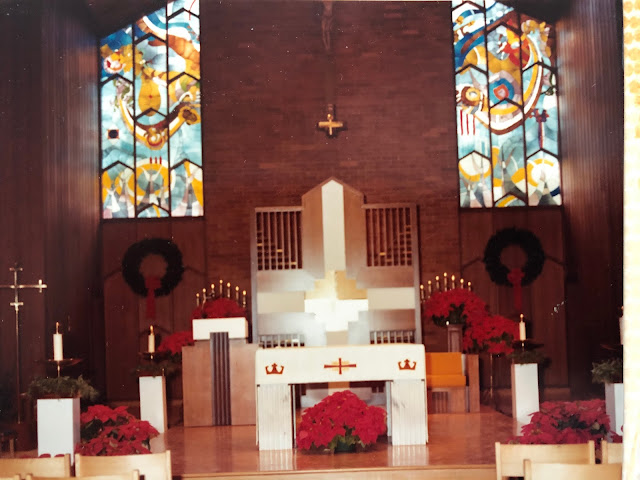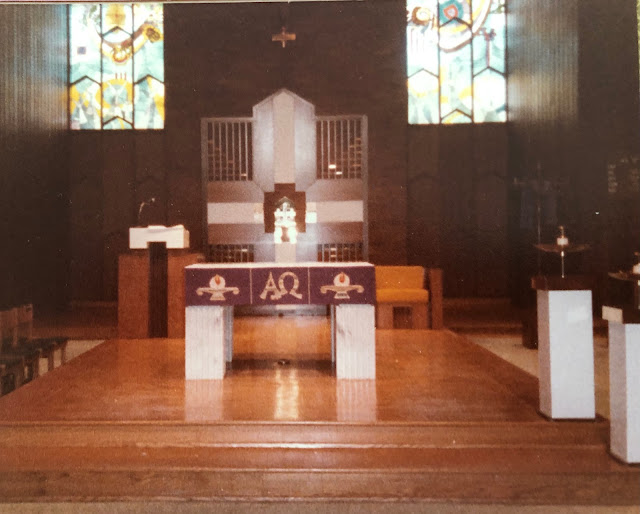Theoretically, I understand why the tabernacle or at least the Blessed Sacrament, should not be present during the celebration of Mass which brings about the glorified “unbloody” Holy Sacrifice of Christ at Calvary as well as His real, substantial, sacramental and glorified Body, Blood, Soul and Divinity.
In the Antecedent Pontifical Mass, the tabernacle was to be empty for the Bishop’s celebration of Holy Mass and I believe the doors open to show that.
But the post-Vatican II solutions to this “problem” were horrible. The tabernacle was dethroned from its central axis in churches and the clericalized priest’s throne place there.
Or the tabernacle was shunted to a side altar to compete with “lesser” popular devotions. Or even worse, place in some distant closet or room, euphemistically called a “chapel”.
But this solution from Rambusch and Company during my first assignment at St. Teresa Church in Albany, Georgia was a great and wonderful solution in the late 1970’s early 80’s. Even then, there was great push back at what was happening to the tabernacle and its “dethronement”.
I still love this solution and this screen which was about $20,000 in 1980 and was considered liturgical art. It and the true abstract art of the stained glass windows installed about the same time, have since then been trashed. Those two windows were about $25,000 1980’s dollars! And yes, these are art from a monk at the Trappist Monastery of the Holy Spirit in Conyers, Georgia.
But alas—iconoclasm lives on:
But here is the wonderful post-Vatican II solution to the conundrum of the tabernacle and keeping it central!
Yes, the doors slide open to revel the tabernacle which can be approached and opened on either side. When I was there, the sliding doors were closed for Mass, but remained opened after the Blessed Sacrament was placed in the tabernacle after Holy Communion and remained opened after Mass. Our church was unlocked for prayer from 7 am to 7pm each day.
The last photo shows me acting as MC for Bishop Lessard who came to St. Teresa’s for its 25TH anniversary Mass in this building. I had mc’d the rededication of the church and consecration of the new free standing altar earlier. These events led Bishop Lessard to name me his MC and Diocesan Director of Liturgy in 1985 when I was transferred to the Cathedral in Savannah. Please note that I am not wearing a cassock as I had none! My seminary in Baltimore did not allow it. When I got to the Cathedral, I planned to use my alb to MC there too. But Bishop Lessard insisted I wear a cassock and surplice and under holy obedience I complied.



7 comments:
The stained glass windows are gorgeous! What a shame they were removed. What replaced them?
You can she renovation pics here:
https://stteresaschurch.org/parish-photos/
I don’t dislike the new windows but still . . . . What happened to the old stained glass windows? You say they were “trashed” but hopefully only from that church and they were sold or donated elsewhere. Also, did they keep what looks like a similar but much larger abstract stained glass window over the entrance?
All the stained glass was placed in the church in the early 80’s. I believe all remain including the one above the entrance. That one used way to much bright red colors and in the spring at sunrise which coincided with the early Mass the sun was blinding for those facing the congregation from the altar.
I have no idea what happened to the ones above the altar.
During Divine Liturgy in the Byzantine Church, the following will/may happen regarding the consecrated elements: 1) They are consumed by the priest to complete the sacrifice; 2) They are distributed to the faithful; 3) Consecrated particles with some Precious Blood are reserved in a small decorated bread box within the tabernacle on the altar for Presanctified Liturgy or distribution to the sick/homebound (dried and if not distributed, periodically consumed and replaced to ensure the integrity of the sacrament is not compromised). Such particles are transported in a pyx that hangs around the priest's neck. Within the pyx is a small spoon to aide with distribution to the communicant. That which wasn't distributed at Divine Liturgy and will not be reserved is consumed by the priest or deacon. This action takes place at the proskomedia table, the table of preparation to the left of the holy table (altar). The ablutions immediately follow.
To me, the tabernacle should be present during the celebration of Mass. Christ present in the blessed sacrament is the same yesterday, today or tomorrow - whenever the consecration took place. Why the tabernacle would ever take a lower place in a consecrated church defies logic. Why reservation was ever made so overly complicated with special doors, screens, iron bars, closet chapels or repurposed side altars also defies logic. In other words, because the tabernacle is effectively abused as a practical matter, to me, there is nothing more silly than Jesus commuting in from the side altar or a non-visible chapel to join Jesus on the altar.
The pictures show a sanctuary seemingly constructed from old packing-cases. I don't particularly like non-pictorial stained glass, but I suppose that working out what it may or may not represent would provide a welcome distraction from the banal 'liturgy' celebrated beneath. I also asssume that MC stands for 'microphonii curator'(sorry, Fr Allan).
The placement of the tabernacle on the main altar is a fairly recent fashion. In medieval England the Sanctissimum was reserved in a 'hanging pyx' usually in the shape of a dove. In many European countries it was kept in an elaborate 'sacrament house' and I have seen this laudable tradition revived in Germany. In a cathedral it is normally in a dedicated chapel, and even now it is customarily removed from a central tabernacle when a bishop celebrates.
When Mass is celebrated versus populum the priest should not have his back to the tabernacle, and too many so-called traditionalists think that in ad orientem celebration the priest offers Mass 'towards the tabernacle'.
Post a Comment